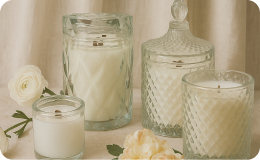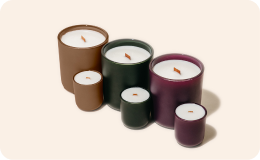Fragrance Glossary

A
Absolute Concentrated
Highly aromatic oily mixtures extracted from plants. The method by which they are extracted affects the odor of the absolute.
Accord
A blend of materials targeting a specific odor or odor type that can be used as the basis of a fragrance or added to build complexity.
Ambergris
A biologic substance expelled from the digestive tract of the sperm whale. Upon aging on the open water, exposed to sun and salt, it develops a unique warm, balsamic odor. It is highly prized for this odor and its fixative properties, but is rarely used.
Amber
Amber, as it is used in perfumery, is not related to the fossilized resin of the same name. A perfumers Amber is an accord, usually based on labdanum, which imparts a warm, sensual, lightly sweet, balsamic odor.
Animalic
An odor group used to describe the sharp, tangy, sensual, and warm characteristics of the extracts made from certain animals: civet, beaver, musk deer and sperm whale. With the exception of the Sperm Whale, harvesting the materials results in the death of the animal. To ease consumer sensibilities a variety of similar synthetic chemicals have been developed.
Aromatic
Traditionally used to describe the very large group of plants and herbs used as flavorings in various cuisines. A few examples are: Basil, Anise, Sage, Dill, Lemongrass, Spearmint.
B
Balsam
A resin or sap which forms on various trees and shrubs such as myrrh and evergreens. Balsamic odor classification is warm, rich, and slightly sweet.
Base
The foundation of a fragrance, the base delivers the undertones that modify and enhance the layers above it, and becomes more evident as the fragrance is worn.
Blotter
A compressed paper of varying thicknesses used to evaluate or showcase a fragrance.
Bouquet In traditional perfumery, this describes the aroma of a complete and properly aged fragrance. It is the combined effect of the individual ingredients after any interactions have completed. It has a similar meaning in the descriptions of wine.
C
Chypre
A classical accord named for the Isle of Cyprus. It is made by blending Oakmoss with Bergamot, a floral (usually Rose or Jasmine), Patchouli and Cedarwood. It is a very versatile accord and can be enhanced by adding green, fruity or citrus notes. This accord is suitable for feminine and masculine fragrances.
Citrus Oils
Among the most valuable oils used are those obtained from fruits such as orange, lemon, lime, tangerine, mandarin and bergamot. They impart freshness to fragrances.
Cloying
Term used to describe an extremely strong and overly sweet or heady fragrance.
Concrete
An extraction method that uses a solvent, usually hexane or benzene, to separate the fragrant components of a botanical material. The solvent is evaporated and the resulting waxy material is the concrete. This can be used as is or is refined into absolute.

D
Diffusion
Diffusion is the rapid evaporation of a fragrance. A fragrance that can quickly fill a space with its scent is said to be diffusive. (i.e. cologne radiating off the skin or a scented candle filling the room with scent)
Distillation
Distillation is the process in which steam is used to release the volatile components of botanical for use in fragrance. The recovered product is known as an essential oil. Flowers, leaves, stems, wood and seeds are all distilled to produce essential oils.
Drydown
The drydown is the final portion of the evaporation process of a fragrance. The drydown is also referred to as the bottom. The scent remaining on the skin after many hours or on clothes coming out of the dryer would be considered the drydown.
E
Enfleurage
An ancient process of releasing the volatile components from delicate flowers such as tuberose. The flowers are placed on fat until their scent is absorbed into the fat. The fat is then removed leaving the fragrant portion known as absolute pomade.
Essential Oils
The volatile product obtained from botanicals via distillation.
Evaporation
The process of changing from liquid to vapor.
Expression
The process of obtaining the volatile oils from citrus peels by mechanical pressure applied to the peels is known as expression.
Extraction
Extraction is the process in which the volatile materials are released from botanicals by solvent. The product obtained is called the concrete. Ethyl alcohol is used to remove the insoluble waxes from the concrete to form the absolute.
F
Fixatives
Fragrance raw materials that are used to slow the evaporation process.
Flowery
A term used to describe the aroma of a flower, such as jasmine, rose, lily, etc.
Fougere
A class of fragrances or an accord which contains citrus, lavender, oakmoss and coumarin.
Fragrance
A blend of raw materials, natural and synthetic, combined to make any odor.
Fresh
A highly subjective term applied to fragrances that have a light, sparkling top note. This effect is often achieved by using citrus notes, although not exclusively.
G
Gourmand
In fragrance, referring to the odor of food or desserts that are baked.
Green
A term used to describe a nature inspired aroma that may consist of plants and vegetation and is crisp, earthy, stem like, leafy or fresh.
H
Hedonic
In fragrance, pertaining to the level of liking or acceptance of a scent.

I
Infusion
Dilution of botanicals, like Vanilla bean, in alcohol.
L
Lift
The amount of diffusion a fragrance exhibits in a product. Highly diffusive fragrances have good lift.
M
Maceration
Fragrance Maceration: The aging of fragrances in alcoholic solutions. Maceration time can vary greatly and affects the body and strength of the finished perfume.
Maceration Extraction: In this process of extraction, the flowers are soaked in hot oil to have their cell membranes ruptured and the hot oil then absorbs the essence of the flowers.
Middle Notes
Middle notes emerge just before the top notes dissipate, usually after 1-2 hours on a blotter. They are the body of the fragrance and help cover base notes that take time to develop their depth and richness.
Modern
A subjective interpretation used to describe a fragrance composition updated using current trend accords.
Mossy
Mossy notes are reminiscent of the rich depths of a forest. Musk Originally derived from the gland of the male Musk Deer, it has been replaced by the use of synthetic musks. There are a large variety of synthetic musks whose odors range from dark and animalic to fresh and laundry-like. They have the unique ability to balance a fragrance composition and add a subtle touch of sensuality and warmth. Musks also act as a fixative, giving the fragrance longer lasting power.
N
Notes
How an ingredient smells in a fragrance but is sometimes loosely used for an entire accord.
O
Olfactive
Pertaining to the sense of smell, or how a fragrance smells.
Oriental
A unique blend of citrus, warm amber and vanilla notes. Often this accord is enhanced with precious woods, exotic floral or spicy undertones. Oriental notes can make a fragrance full-bodied and add warmth and sensuality.
P
Perfume Types
Grouping by olfactive family is a starting point to describe fragrances but it cannot by itself denote all the characteristics of that fragrance. The traditional classification categories are: Floral-oriental-amber-woody-leather-chypre-fougere. More categories have come into existence like green, ozonic or gourmand.
Pomade
Pomades are prepared perfume materials that are obtained through the enfleurage process. The fat saturated with oil from the flowers is known as the pomade.
Powdery
Powdery applies to a natural or synthetic note that gives the feeling of dryness associated with talcum powder or chalk. Many people associate powdery with the “smell of a baby” or baby powder. Powdery notes can take on sweeter nuances or drier ones depending on what the perfumer is trying to accomplish.
R
Round Out
In fragrance, to add body, fullness or depth as a means to complete or enhance a fragrance composition.

S
Spicy
Fragrance classification relating to strong botanical extracts such as cinnamon, clove ginger or pepper.
Stability
Term used to refer to a fragrances ability to be nonreactive with itself or its base. Fragrances are made stable to avoid issues such as discoloration. Stability tests try to replicate potential long term storage issues before a product goes to market.
Strength
The relative power of a fragrance blend.
Substantivity
The overall strength and lasting power over time.
Sweet
A fragrance category classified by the level of vanillic, sugary notes. Sweet notes are typically bottom notes that last the longest.
T
Thin
A fragrance lacking in complexity or body. A thin fragrance is very linear or single noted.
Top Note
The very first perceived part of a fragrance. It usually consists of citrus notes and/or light fruity or green notes. The top notes are the first to dissipate.
U, V, W
Undertone
The underlying feeling or quality of a fragrance.
Volatile
The measure of how fast a fragrance vaporizes, evaporates, or diffuses.
Woody
A fragrance term associated with fresh cut wood. Woody notes can be subdivided ever further.
Warm
Opulent woody notes such as sandalwood or patchouli, or dry aromatic notes such as cedarwood or vetiver can all be used to enhance a fragrance composition.









